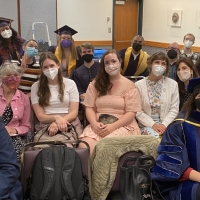Museum on the Move!
Interview with Museum Registrar, Gina Caprari
Thousands of objects, dozens of students, 7 years, 3 buildings = 1 collection! “Move” pretty much summarizes our activities since the Program reorganized in 2014 and opened the Global Museum in 2018! As the museum got its legs with two exhibitions and successful run of events and public programming in its first two years, it shuttered temporarily along with the world in 2020. But time and collections care wait for no person or pandemic: the museum still had a major collections move on the schedule! While we were in remote classes this year, Global Museum staff completed a comprehensive collection move that consolidated thousands of objects stored across the campus during the reorganization and museum opening into preservation facilities in Fine Arts and newly renovated spaces in Humanities. Supported by SF State personnel and a small group of students on site, the move was completed in a matter of days, all while meeting safety protocols! In our small work bubble, students are researching the newly consolidated objects and getting hands-on collections care experience like object handling, rehousing, cataloguing, and more.
Integral to the move and the resulting collections management is Global Museum registrar and Museum Studies lecturer, Gina Caprari. Gina came on board in 2015 and is helping to transform a University collection of thousands of objects into a well-organized, carefully cataloged, and properly housed collection. Gina was at the center of all the action, from ideation to completion to hopefully, a little relaxation with her furry companion, Rita! She took the time to answer a few questions about this historic move and what it entailed.
Can you give us a short overview of the collections the Global Museum stewards? Where did the collections come from, how did the Global Museum become responsible for them, etc.?
The Global Museum was founded by San Francisco State University to unite campus collections housed in various areas, under stewardship of museum professionals in the Museum Studies program. Serving as a teaching lab for the Museum Studies program, the Global Museum offers the opportunity for students to work hands-on with permanent collections in a fully functioning museum. The University collections include objects from all around the world and across time, from the ancient Egyptian collection to more contemporary material culture from Africa, Asia, Oceania, and the Americas.
Why was the collections move necessary?
Our goal was always to find a suitable permanent home for University collections stewarded by the Global Museum, in which students, staff, and faculty could work together to provide long-term care for the objects. It took several years, but with creativity, resourcefulness, and commitment from partners, we were able to identify and rehabilitate an excellent space.
How long did it take to plan and implement the move?
When the Global Museum took on stewardship of the University’s collections, objects were originally moved into a temporary space—in many ways, we were planning this permanent move from the moment the Global Museum was founded in 2014, one year before I even came on to the team! As the Registrar, it’s been on my mind from day 1.
What was the biggest challenge and/or unforeseen obstacle?
No matter how much planning you do (and we do a lot), something always comes up during a collections move! Fortunately, our team is well-trained at adjusting plans responsibly in order to achieve our move goals while also keeping people and collections safe. I’d say one of the biggest challenges was that, in true San Francisco microclimate style, it unexpectedly rained on our first move day—but like any good museum professionals, we were prepared for this with an adjusted strategy (which included plastic sheeting, additional choreography, and a positive attitude).
Who helped make the move happen? (assistants, staff, SFSU partners, etc.)
Under the guidance of Global Museum staff, Museum Studies students have been at the core of this endeavor from the very start, and are responsible for so much of the work that had to be done in order to make this move possible. Years of inventory, condition reporting, rehousing, environmental monitoring, integrated pest management, developing policy and procedures, designing move strategies—and on the other side, identifying landing spaces for complex objects, setting up operations in the new facility, updating data, adjusting object placement, researching storage methods… and so much more.
In addition, we worked closely with campus partners in Capital Planning Design and Construction, Risk Management, Facilities Services, Academic Resources, as well as contractors and vendors to design and install new shelving, implement security strategies, and even upgrade areas to LED lighting. It was a very big project, and we’re so grateful to everyone who contributed to making this happen. There is plenty more to do now that the objects are in a permanent home, and our students will be working with these collections far into the future—but we are very glad that the move is complete!
